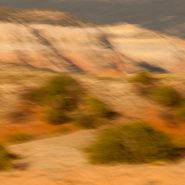
At last, four years ago, I transferred completely over to Digital Capture. For 6 years prior to that I lived in both camps. When I first began experimenting with digital cameras, I quickly realized that although the immediate digital feedback – reducing a subject’s composition to its two dimensional elements — most assuredly informed my shooting, the quality of the digital image didn’t come close to providing the detail or sharpness of a print made from film.
As we have all seen, the developments in digital capture have been nothing short of amazing, with the image quality (resolution) improving with each new camera. Today there are 35mm digital cameras with sensors having 10 times the resolution of ten years ago. For the last three years, I have been shooting a Canon EOS 5D Mark II having a 21 MegaPixel sensor which enables the creation of my 48” wide exhibition prints that have amazing resolution, clarity and color.
In short, I think it is fair to say that digital capture now equals film capture in all respects, except for possibly some techniques still practiced by vintage printing purists. And I expect within another few years, digital capture will provide image resolution that surpasses the finest grain film, thus eliminating the need for medium and large format cameras in most instances.
Of course, image resolution is just the most immediate advantage that digital capture provides over film. The ability to download digital capture onto a laptop in the field makes it possible to further improve an image on the spot even for the photography purist that limits image correction to modifying contrast or exposure as they have done for nearly 150 years in a wet lab. To say nothing of the ability to transmit a digital image file to either an Ink-jet or Light-jet print lab close by, or to almost anywhere instantaneously via the internet.
And lastly, a huge advantage that isn’t talked about as much is that digital capture results in images which can be organized and stored on a hard drive with software today that enables the cataloging, keywording, and copying of these digital image files, as contrasted with the belabored organization and filing of bulky film negatives.